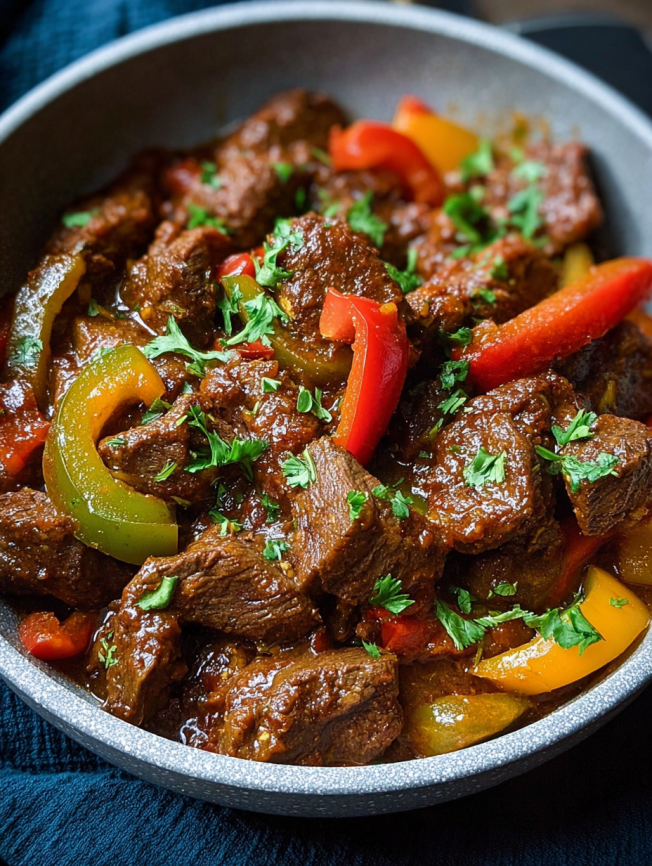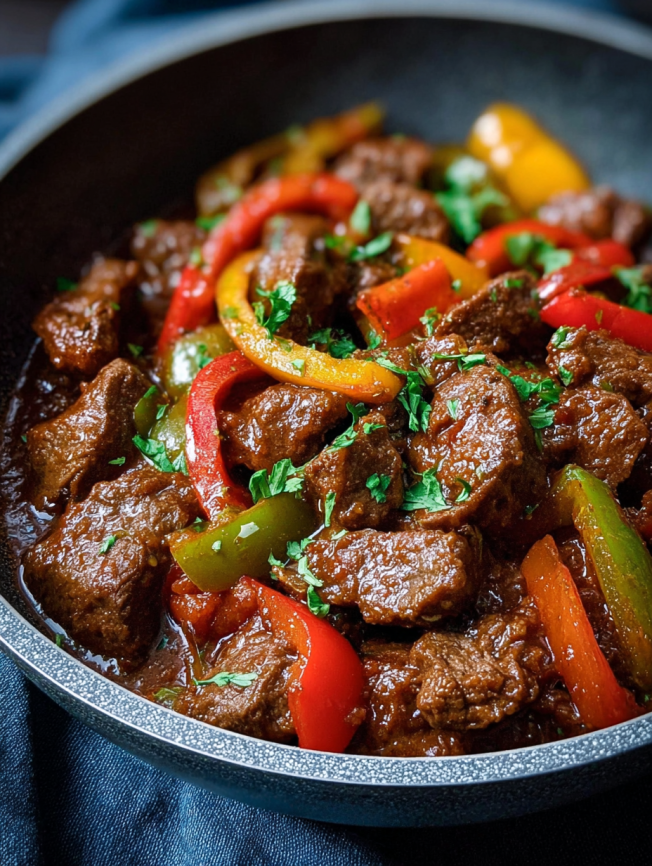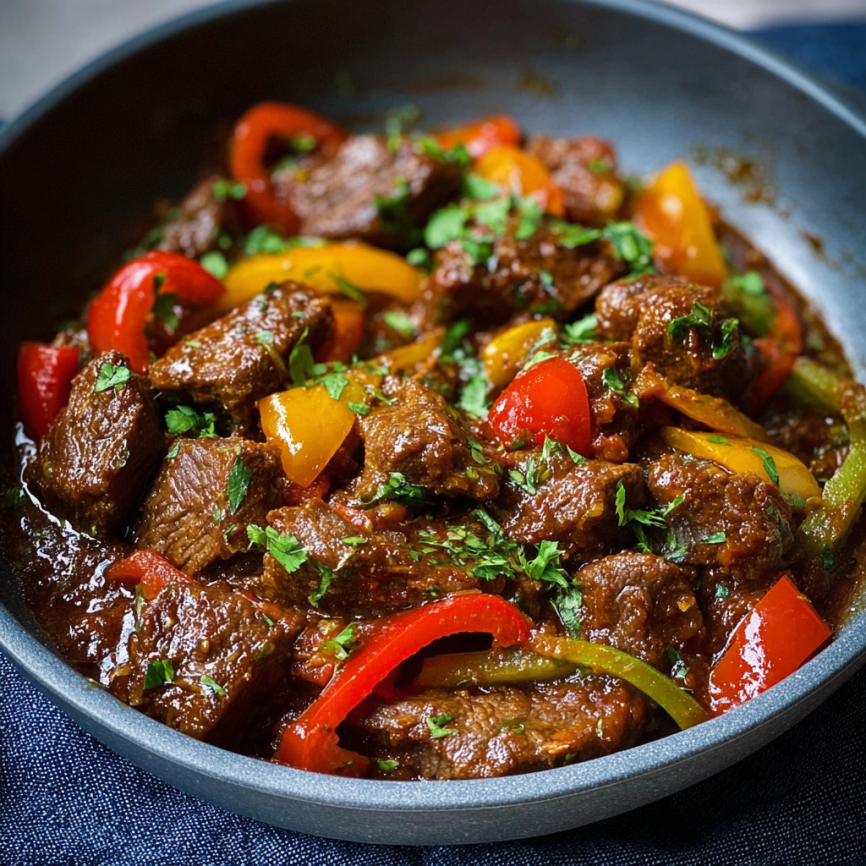The first time I tasted Awaze Tibs at a small Ethiopian restaurant tucked away in my neighborhood, I knew I had discovered something extraordinary. The tender beef cubes glistening with aromatic niter kibbeh, the fiery kick of awaze sauce dancing on my tongue, and the communal experience of sharing injera with friends created an unforgettable culinary moment. Since then, I’ve been perfecting this recipe in my own kitchen, and I’m thrilled to share this journey into Ethiopian cuisine with you.
This dish represents everything beautiful about Ethiopian cooking – bold spices, rich traditions, and flavors that tell a story. Furthermore, it’s surprisingly accessible for home cooks, requiring just a handful of authentic ingredients and simple techniques to create restaurant-quality results.
Why You’ll Become Obsessed with This Recipe
A Gateway to Ethiopian Cuisine
Awaze Tibs serves as the perfect introduction to Ethiopian flavors without overwhelming novice palates. The dish balances heat with savory richness, creating a complex flavor profile that’s both exciting and approachable. Unlike some traditional Ethiopian dishes that require lengthy preparation, this stir-fry comes together in just 25 minutes.
Versatility Meets Authenticity
While deeply rooted in tradition, Awaze Tibs adapts beautifully to modern dietary preferences. Serve it traditionally with injera for an authentic experience, or pair it with cauliflower rice for a keto-friendly version. Additionally, the recipe scales easily for intimate dinners or larger gatherings, making it perfect for both weeknight meals and dinner party centerpieces.
Incredible Flavor Payoff
The magic happens when tender beef meets the complex heat of awaze sauce and the aromatic richness of niter kibbeh. Each bite delivers layers of flavor – the earthiness of berbere spices, the warmth of garlic and ginger, and the satisfying richness of properly seared beef. Moreover, the quick cooking method ensures the meat stays tender while developing beautiful caramelization.
Essential Ingredients and Their Roles
The Protein Foundation
- 1 lb beef sirloin or stew meat, cut into bite-sized cubes (choose well-marbled cuts for maximum tenderness)
- Salt to taste (enhances natural beef flavors)
The Flavor Base
- 2 tablespoons niter kibbeh (Ethiopian spiced clarified butter that adds aromatic richness)
- 1 medium red onion, sliced (provides sweetness and depth)
- 1 tablespoon minced garlic (essential for authentic Ethiopian flavor)
- 1 tablespoon minced ginger (adds warmth and complexity)
The Heat and Color
- 2 tablespoons awaze sauce (the star ingredient that gives the dish its signature spicy kick)
- 1 bell pepper, sliced (adds crunch and mild sweetness to balance the heat)
- 1 tablespoon olive oil, optional (for extra moisture if needed)
Finishing Touches
- Fresh rosemary or jalapeños (optional garnishes that add visual appeal and extra flavor)
Mastering the Cooking Technique
Setting Up for Success
Begin by heating a large skillet over medium-high heat – this temperature ensures proper searing without burning the aromatic spices. Add the niter kibbeh and allow it to melt completely, releasing its complex blend of spices and creating the flavorful base for your dish.
Building the Aromatic Foundation
Once the niter kibbeh is hot and fragrant, add the sliced onions. Sauté them until they become translucent and slightly caramelized, which typically takes 3-4 minutes. This step is crucial because properly cooked onions add sweetness that balances the heat of the awaze sauce.
Next, stir in the minced garlic and ginger, cooking for just one minute until fragrant. Be careful not to burn these aromatics, as they can become bitter and overpower the dish’s delicate balance.
Perfecting the Beef
Add the beef cubes to the aromatic base, ensuring they’re in a single layer for proper searing. Allow them to brown on all sides without moving them too frequently – this develops the rich, caramelized flavors that make the dish exceptional. The beef should be nicely browned but still tender inside.
The Magic Moment
Mix in the awaze sauce, stirring carefully to coat each piece of beef evenly. The sauce will sizzle and release incredible aromas as it hits the hot pan. This is where the dish truly comes alive, as the spicy sauce mingles with the rendered beef juices and aromatic base.
Final Assembly
Add the sliced bell peppers and sauté until they’re tender but still retain a slight crunch. This textural contrast is important for the overall eating experience. Season with salt to taste, then cook for an additional 5 minutes to allow all flavors to meld together harmoniously.

Serving Suggestions and Presentation
Traditional Ethiopian Style
For an authentic experience, serve Awaze Tibs with injera, the spongy sourdough flatbread that’s essential to Ethiopian dining. The injera not only complements the spicy flavors but also serves as both plate and utensil in traditional Ethiopian meals. Arrange the beef on a large platter lined with injera, allowing diners to tear off pieces of bread to scoop up the meat.
Modern Adaptations
Health-conscious diners can enjoy this dish over cauliflower rice, which absorbs the flavorful sauce beautifully while keeping the meal low-carb. Alternatively, serve it alongside sautéed greens like collards or spinach for added nutrition and color contrast.
Elegant Presentation
For dinner parties, consider serving individual portions in small cast-iron skillets to maintain the dish’s temperature and create an impressive presentation. Garnish with fresh rosemary sprigs or thinly sliced jalapeños for visual appeal and extra flavor.
Creative Recipe Variations
Heat Level Adjustments
While traditional Awaze Tibs packs considerable heat, you can easily adjust the spice level to suit different palates. For milder versions, reduce the awaze sauce by half and add it gradually until you reach your desired heat level. Conversely, heat enthusiasts can add extra awaze or incorporate fresh jalapeños for an even spicier experience.
Protein Alternatives
Though beef is traditional, this cooking method works beautifully with lamb, goat, or even chicken thighs. Lamb adds a rich, gamey flavor that pairs exceptionally well with Ethiopian spices, while chicken thighs remain tender and absorb the awaze sauce wonderfully.
Vegetable Additions
Experiment with additional vegetables like mushrooms, tomatoes, or green beans to create a more substantial dish. Add heartier vegetables early in the cooking process and delicate ones toward the end to maintain proper textures.
Make-Ahead Tips and Storage Solutions
Preparation Strategies
The beef can be cut and seasoned up to 24 hours in advance, allowing the salt to penetrate the meat and enhance its flavor. Store the prepared beef covered in the refrigerator until ready to cook. Additionally, you can slice all vegetables ahead of time and store them in separate containers for quick assembly.
Batch Cooking Benefits
This recipe doubles or triples easily, making it perfect for meal prep. Cook larger batches and portion them into individual containers for quick weeknight dinners throughout the week. The flavors actually improve after a day in the refrigerator as the spices continue to meld.
Proper Storage Methods
Cooked Awaze Tibs keeps well in the refrigerator for up to four days when stored in airtight containers. For longer storage, freeze portions for up to three months. When reheating, add a splash of water or broth to prevent the meat from drying out.
Important Notes for Authentic Results
Sourcing Authentic Ingredients
While niter kibbeh and awaze sauce can be found at Ethiopian markets or online, you can make substitutions if necessary. High-quality clarified butter mixed with a pinch of cardamom and fenugreek can approximate niter kibbeh, though the flavor won’t be exactly the same.
Cooking Temperature Control
Maintaining proper heat throughout cooking is crucial for success. The temperature should be high enough to sear the beef and develop flavors but not so high that the spices burn. If your pan gets too hot, reduce the heat slightly and add a tablespoon of water to cool it down.
Spice Balance Considerations
Ethiopian cuisine relies heavily on the balance between heat, aromatics, and richness. Taste your dish as you cook and adjust seasonings accordingly. Some awaze sauces are spicier than others, so start with less and add more to achieve your preferred heat level.

Frequently Asked Questions
Q: Where can I find niter kibbeh and awaze sauce if I don’t have an Ethiopian market nearby? A: Many online retailers sell authentic Ethiopian ingredients, including specialty spice companies and Amazon. You can also make your own niter kibbeh by clarifying butter with spices like cardamom, cinnamon, and fenugreek. For awaze sauce, look for berbere spice blend and mix it with tomato paste and a touch of honey.
Q: Can I make this dish less spicy without losing the authentic flavor? A: Absolutely! Start with just one tablespoon of awaze sauce and taste as you go. You can also balance the heat by adding a touch of honey or increasing the amount of bell peppers and onions. The key Ethiopian flavors come from the niter kibbeh and aromatics, not just the heat.
Q: What cut of beef works best for this recipe? A: Sirloin and tenderloin are excellent choices because they cook quickly and stay tender. However, if you prefer more economical cuts, chuck roast or stew meat work well too – just cut them into smaller pieces and cook a few minutes longer to ensure tenderness.
Q: How do I know when the beef is cooked properly? A: The beef should be browned on all sides but still slightly pink in the center for optimal tenderness. Since the pieces are small, they cook quickly – usually within 5-7 minutes of searing. Overcooking will make the meat tough and chewy.
Q: Can I prepare this dish for guests who aren’t familiar with Ethiopian cuisine? A: This recipe is perfect for introducing people to Ethiopian flavors! Consider serving it alongside familiar sides like rice or roasted vegetables, and provide cooling elements like yogurt or cucumber salad. Start with less awaze sauce for heat-sensitive guests and offer extra on the side.
Prep Time: 10 minutes | Cooking Time: 15 minutes | Total Time: 25 minutes
Calories: 295 kcal per serving | Servings: 4

